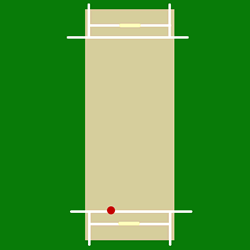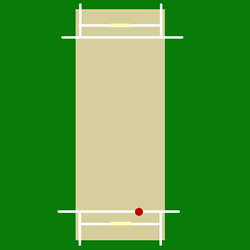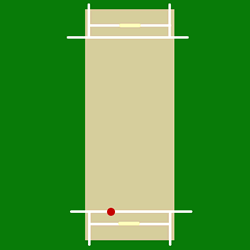Related Research Articles

Leg spin is a type of spin bowling in cricket. A leg spinner, also called leggie, bowls right-arm with a wrist spin action, causing the ball to spin from right to left in the cricket pitch when the ball bounces, that is, away from the leg side of a right-handed batsman. The same kind of trajectory, which spins from right to left on pitching, when performed by a left-arm bowler is known as left-arm unorthodox spin bowling.

Left-arm orthodox spin, also known as slow left-arm orthodox spin bowling, is a type of left-arm finger off spin bowling in the sport of cricket. Left-arm orthodox spin is bowled by a left-arm bowler using the fingers to spin the ball from right to left of the cricket pitch.
The flipper is the name of a particular bowling delivery used in cricket, generally by a leg spin bowler. In essence it is a back spin ball. Squeezed out of the front of the hand with the thumb and first and second fingers, it keeps deceptively low after pitching and can accordingly be very difficult to play. The flipper is comparable to a riseball in fast-pitch softball.

Off spin is a type of finger spin bowling in cricket. A bowler who uses this technique is called an off spinner. Off spinners are right-handed spin bowlers who use their fingers to spin the ball from a right-handed batsman's off side to the leg side. This contrasts with leg spin, in which the ball spins from leg to off and which is bowled with a very different action.
In cricket, a googly is a type of deceptive delivery bowled by a right-arm leg spin bowler. In Australia, it is usually referred to as a wrong'un, or occasionally as a Bosie or Bosey, the last two eponyms in honour of its inventor Bernard Bosanquet. A leg spin bowler bowls in a leg spin way but it goes in the off spin direction.

This is a general glossary of the terminology used in the sport of cricket. Where words in a sentence are also defined elsewhere in this article, they appear in italics. Certain aspects of cricket terminology are explained in more detail in cricket statistics and the naming of fielding positions is explained at fielding (cricket).
A doosra is a particular type of delivery by an off-spin bowler in the sport of cricket. The doosra spins in the opposite direction to an off break, and aims to confuse the batsman into playing a poor shot.

Pace bowler is one of two main approaches to bowling in the sport of cricket, the other being spin bowling. Practitioners of pace bowling are usually known as fast bowlers, quicks, or pacemen. They can also be referred to as a seam bowler, a swing bowler or a 'fast bowler who can swing it' to reflect the predominant characteristic of their deliveries. Strictly speaking, a pure swing bowler does not need to have a high degree of pace, though dedicated medium-pace swing bowlers are rarely seen at Test level these days.

Spin bowling is a bowling technique in cricket and the bowler is referred to as a spinner.
An arm ball is a type of delivery in cricket. It is a variation delivery bowled by an off spin bowler or slow left-arm orthodox bowler. It is the finger spin equivalent of a wrist spinner's slider or zooter.

An off break is the type of delivery in the sport of cricket. It is the attacking delivery of an off spin bowler. Off breaks are known as off spinners.

A leg break is a type of delivery in the sport of cricket. It is a delivery of a right-handed leg spin bowler.
In the sport of cricket there are two broad categories of bowlers: pace and spin. Pace bowlers rely mostly on the speed of the ball to dismiss batsmen, whereas spin bowlers rely on the rotation of the ball.

A delivery or ball in cricket is a single action of bowling a cricket ball toward the batsman.
West Indies cricket team toured Sri Lanka for two Test matches and an ODI tri-series in July and August 2005. West Indies were severely depleted owing to a contract dispute, which led to players like Brian Lara, Chris Gayle and Corey Collymore refusing to play. Thus, Sri Lanka went into the series as even more overwhelming favourites, their strong game at home and West Indies' poor form – with only one Test win in the last ten attempts. And they confirmed their favourite status, winning both Tests in rather emphatic style, although their batting showed worrying weaknesses against West Indian bowlers who bowled with more heart than talent at times.

Wrist spin is a type of bowling in the sport of cricket. It refers to the cricket technique and specific hand movements associated with imparting a particular direction of spin to the cricket ball. The other spinning technique, usually used to spin the ball in the opposite direction, is finger spin. Wrist spin is bowled by releasing the ball from the back of the hand, so that it passes over the little finger. Done by a right-handed bowler, this imparts an anticlockwise rotation to the ball, as seen from the bowler's perspective; a left-handed wrist spinner rotates the ball clockwise.
Finger spin is a type of bowling in the sport of cricket. It refers to the cricket technique and specific hand movements associated with imparting a particular direction of spin to the cricket ball. The other spinning technique, generally used to spin the ball in the opposite direction, is wrist spin. Although there are exceptions, finger spinners generally turn the ball less than wrist spinners. However, because the technique is simpler and easier to master, finger spinners tend to be more accurate.

In ball sports, topspin is a property of a ball that rotates forwards as it is moving. Topspin on a ball propelled through the air imparts a downward force that causes the ball to drop, due to its interaction with the air. Topspin is the opposite of backspin.
In cricket, a slider is a type of delivery bowled by a wrist spin bowler. While a topspinner is released with the thumb facing the batsman, a slider is bowled in a similar manner to a legbreak, but instead of imparting sidespin with the third finger, the bowler allows his fingers to roll down the back of the ball, providing a mixture of sidespin and backspin. Whereas a topspinner tends to dip more quickly and bounce higher than a normal delivery, a slider does the opposite: it carries to a fuller length and bounces less than the batsman might expect. The sliders will typically head towards the batsman with a scrambled seam. This has less effect on the flight and bounce but absence of leg spin may deceive the batsman. Frequently the slider is bowled with a mixture of side spin and backspin. This has the effect of making the ball harder to differentiate from the leg break for the batsmen without reducing the mechanical effects caused by the backspin. This delivery may skid straight on or it may turn a small amount.

Technique of bowling leg spin by using fingers
References
- ↑ Peter Philpott "The Art of Wrist Spin Bowling"
- ↑ http://video.google.com/videoplay?docid=-1622125182818951912#
- ↑ Bob Woolmer "the Art and Science of Cricket"
- ↑ Peter Philpott "The Art of Wrist Spin Bowling"